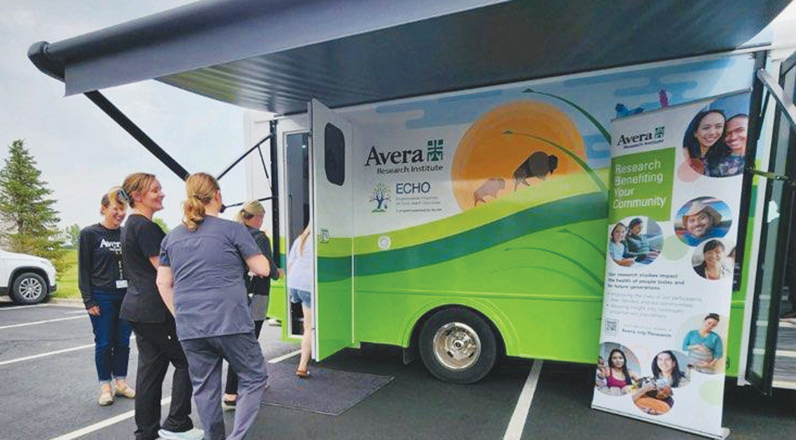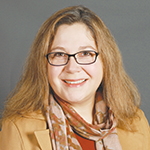
The Avera Research Institute is using its new mobile unit to reach people in remote parts of Avera Health's service area, allowing them to participate in the institute's studies.
The Avera Research Institute is on the move — literally.
The institute, part of Avera Health, recently acquired a 25-foot mobile research unit, a 2023 Turtle Top Terra Transit vehicle, that travels around the state. It is mostly based in Pierre, South Dakota, which is centrally located and gives easier access to partnering with tribal nations and rural communities.
At its "bricks and mortar" site in Sioux Falls, the Avera Research Institute also is involved in studies on cancer among American Indians, substance use and reproductive health, and food as medicine.

Amy Elliott, the institute's chief clinical research officer, came to Avera five years ago. At that time, the institute had 15 people. It now has close to 80. She recently spoke with Catholic Health World from her office in Sioux Falls about the institute and the new mobile unit. Responses have been edited for length and clarity.
What sets your research institute apart?
A lot of health systems have a research and innovation arm to them that will do, for example, industry clinical trials, especially in the oncology space. What's not as common is having
an infrastructure that also includes a lot of investigator-initiated research and involvement, especially from a community-based health system, and involvement in national networks at the level in which we are involved. And also our size —
we have close to 80 full-time individuals now. We're quite large, actually, in terms of a research institute.
How did you get the mobile unit?
Our mobile unit came through a supplement on a large National Institutes of Health grant that we've been part of for the past seven years called ECHO.
I've always wanted to take research out to people who otherwise may not be able to participate. We kind of have a mantra of bringing cutting-edge research to the prairie. One of the things COVID really taught us is the importance of being able to be nimble and inclusive. Another important lesson learned is that while most people have pretty good internet connectivity, there are still huge pockets, particularly in rural areas, that don't. And connectivity also differs by socioeconomic status.
By bringing things out to people, we can help make sure that we're being more equitable and not limiting who has access to research studies, which can include interventions not available in other settings.
What's inside the unit?
It's got two clinic rooms inside with two entrances, so we can see two families in separate spaces. We're able to do physical exams and developmental assessments, and it's got a blood collection chair
to help make things as comfortable as possible for everyone. We have an awning over the front as well, so if we have it at a health fair, we can set up a table easily and have people going in and out.
It's been fun to watch kids engage and be excited about the unit. We really try to help promote that to kids when they're participating in a research study — you're doing science, you're helping others.
Pictures on social media show the kids wearing little lab coats and a buffalo mascot named Boom Boom. It looks like you have some creative researchers.
Our community engagement team is very creative. We do many activities to
get people excited about research and, more importantly, to get them excited about what they're part of. They're part of contributing to something that can help influence health for kids for generations to come. We really try to embrace everyone
and make everyone feel a part of that vision. Research can be intimidating and finding ways to connect with children and families helps everyone feel part of the larger team that is trying to answer important questions.
Did you all look at other mobile labs to inform how you developed yours?
We consulted with a few colleagues that use mobile units to see how they have theirs designed and lessons learned. We ended up modeling our unit after one
used by Dr. Johnnye Lewis' group at the University of New Mexico. They do many projects in collaboration with the Navajo Nation and have many remote and poor road conditions, so we have much in common with them.
How will including people in rural areas into research benefit the people of your service area?
Oftentimes, rural areas are overlooked when it comes to health research. Given that health research helps determine what becomes
standard of care — for instance, which drugs proven effective move on to general use — if populations aren't included in the formative studies, then the results may or may not be applicable.
We also have nonintervention studies that are looking at childhood development and what early exposures can influence that development. There is sometimes an assumption that "rural" is just a change in geography. However, we know there are many unique aspects to rural living and lifestyles that are important to include.
Two large grants (from the NIH) and our mobile unit make it possible for us to more easily incorporate rural populations in health research.
Tell me about your footprint.
The research institute actually goes beyond the Avera medical and clinical service footprint. We have offices in Sioux Falls, which is on the east side of the state, and also in Rapid City, which
is on the western side of the state. We also have an office in Pine Ridge, which is the largest American Indian reservation in our region.
We are a largely rural state with a significant percent of American Indian residents. The western part of the state has more of the larger reservation lands. On Pine Ridge, there is a high unemployment rate and basic resources, such as housing, are difficult for families. There are many tribal members that work every day to improve life and conditions in that area. I think the tremendous strength and sense of community is often overlooked. What is often highlighted is the problems and challenges.
So many people are working to try to help improve unhealthy conditions. But it really is the work that's happening within the people themselves that is, I think, where the true power of change lies. We are very honored to have been invited and approved to use research to help answer important questions to these communities. We are very cognizant of our role and that the power lies within the people and sense of community.
Some of these studies involve asking personal questions about drug addiction or mental health issues. That has to be a challenge.
This is a challenge and can be difficult on both the participants and staff. This is another reason
why it's important to be able to have options for people to participate. Being able to bring a vehicle to them also just lets people know they're important and lets them answer difficult questions in person or remotely. Our participants are very
generous in telling their life stories and truly are looking for ways to help others. We're able to hold research within a very confidential space. Research is able to happen in a cocoon of sorts, to help protect participants' privacy and confidentiality.
